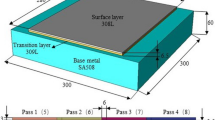Abstract
Austenitic stainless steel is widely used in pressure vessels for the storage and transportation of liquid gases such as liquid nitrogen, liquid oxygen, and liquid hydrogen. Cryogenic pressure vessel manufacturing uses cold stretching technology, which relies heavily on welding joint performance, to construct lightweight and thin-walled vessels. Residual stress from welding is a primary factor in cases of austenitic stainless steel pressure vessel failure. In this paper, on the basis of Visual Environment 10.0 finite element simulation technology, the residual stress resulting from different welding strength matching coefficients (0.8, 1, 1.2, 1.4) for two S30408 plates welded with three-pass butt welds is calculated according to thermal elastoplastic theory. In addition, the stress field was calculated under a loading as high as 410 MPa and after the load was released. Path 1 was set to analyze stress along the welding line, and path 2 was set to analyze stress normal to the welding line. The welding strength matching coefficient strongly affected both the longitudinal residual stress (center of path 1) and the transverse residual stress (both ends of path 1) after the welding was completed. However, the coefficient had little effect on the longitudinal and transverse residual stress of path 2. Under the loading of 410 MPa, the longitudinal and transverse stress decreased and the stress distribution, with different welding strength matching coefficients, was less diverse. After the load was released, longitudinal and transverse stress distribution for both path 1 and path 2 decreased to a low level. Cold stretching could reduce the effect of residual stress to various degrees. Transverse strain along the stretching direction was also taken into consideration. The experimental results validated the reliability of the partial simulation.


























Similar content being viewed by others
References
J.Y. Zheng, C.J. Miao, and B.N. Shou, Light Weight Trend-Pressure Vessel Development Direction, Pressure Vessels Technology, 2009, 26(9), p 42–48
B. Andersson and L. Karlsson, Thermal Stresses in Large Butt-welded Plates, Journal of Thermal Stresses, 1981, 4(3–4), p 491–500
L. Zhu and J.H. Chen, Yielding Behavior of Mismatched Welded Joint and Prediction of its Yielding Strength, Journal of Lanzhou university of technology, 2004, 30(1), p 5–9
L.Y. **ong and Y.H. Zhang, Effect of Strength Mismatching on Elastic-Plastic Deformation Behaviors of Welded Joints with Cracks, China Mechanical Engineering, 2012, 23(6), p 733–738
NEA (National Energy Administration), 2011, “Welding specification for pressure vessels,” NBT47015-2011.
NEA (National Energy Administration), 2010, “Stainless and heat-resisting steel forgings for pressure equipments,” NBT47010-2010.
AQSIQ (General Administration of Quality Supervision, Inspection and Quarantine of the People’s Republic of China), SAC (Standardization Administration of the People’s Republic of China), 2012, “Covered electrodes for manual metal arc welding of stainless and heat-resisting steels,” GBT983-2012.
MIIT (Ministry of Industry and Information Technology), 2016, “Stainless steel wires for welding,” YBT5092-2016.
AWS (American Welding Society), 2012, “Specification for Bare Stainless Steel Welding Electrodes and Rods,” AWS A5.9/A5.9M:2012.
Y.H. Zhang, Principle of welding structure, Bei**g university of aeronautics and astronautics press, Bei**g, 2010
V.A. Vinokurov, Welding Stresses and Distortion: Determination and Elimination, British Library Research & Development Department, London, 1977
AQSIQ (General Administration of Quality Supervision, Inspection and Quarantine of the People’s Republic of China), SAC (Standardization Administration of the People’s Republic of China), 2011, “Stationary pressure vessels,” GB150-2011.
J.C. Gu, L.G. Tong, L. Li, L. Wang, S.W. Yin, and S.W. Bai, Selection Criteria of Heat Source Model on the Welding Numerical Simulation, Materials Review, 2014, 28(1), p 143–146
S.M. Yin, J.D. Meng, C.Q. Wang, Z.Y. Xu, and Y. Wang, Variation of External Constrain Conditions on Stainless Steel Welding Residual Stress, Electric welding machine, 2014, 44(4), p 133–137
A. Krasovskyy, S. Snnichsen, and D. Bachmann, On the Residual Stresses in Multi-pass Welds: Coupling of Welding Simulation and Fatigue Analysis, Procedia Engineering, 2011, 10(2011), p 506–511
D. Deng and H. Murakawa, Numerical Simulation of Temperature Field and Residual Stress in Multi-pass Welds in Stainless Steel Pipe and Comparison with Experimental Measurements, Computational Materials Science, 2006, 37(3), p 269–277
Y.L. Zhang, J.Y. Liu, and X.D. Xu, X-Ray Stress Measurement of Stainless Steel, Journal of Bei**g polytechnic university, 2010, 36(9), p 1165–1173
J.Y. Liu, Study on X-ray residual stress measurement technique and application, Bei**g University of Technology, Bei**g, 2009
D.F. Fu, C.Q. Zhou, C. Li, G. Wang, and L.X. Li, Effect of Welding Sequence on Residual Stress in Thin-Walled Octagonal Pipe-Plate Structure, Transactions of Nonferrous Metals Society of China, 2014, 24(3), p 657–664
W. Jiang and K. Yahiaoui, Effect of Welding Sequence on Residual Stress Distribution in a Multipass Welded Pi** Branch Junction, International Journal of Pressure Vessels and pi**, 2012, 95(2012), p 39–47
D. Deng, Influence of Deposition Sequence on Welding Residual Stress and Deformation in an Austenitic Stainless Steel J-Groove Welded Joint, Materials & Design, 2013, 49(2013), p 1022–1033
D. Deng and S. Kiyoshima, Influence of Annealing Temperature on Calculation Accuracy of Welding Residual Stress in a SUS304 Stainless Steel Joint, Acta Metallurgica Sinica, 2014, 50(5), p 626–632
Y.Y. Liu, J.W. Zang, and X.W. Li, Summarize of Metallographic Sample Preparation Process, Metal World, 2010, 1, p 46–48
Acknowledgments
This research is supported by National Natural Science Funds of China (No. 51775187).
Author information
Authors and Affiliations
Corresponding author
Rights and permissions
About this article
Cite this article
Lu, Y., Hui, H. & Gong, J. Influence of Welding Strength Matching Coefficient and Cold Stretching on Welding Residual Stress in Austenitic Stainless Steel. J. of Materi Eng and Perform 27, 3131–3143 (2018). https://doi.org/10.1007/s11665-018-3366-y
Received:
Revised:
Published:
Issue Date:
DOI: https://doi.org/10.1007/s11665-018-3366-y




